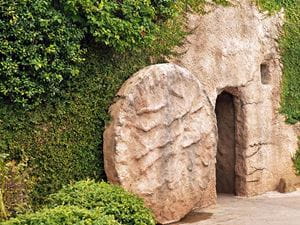
On Easter, we celebrate what is arguably the most important event in all human history: Jesus’ resurrection. The resurrection is the central tenet of Christian theology. Not only does the resurrection witness to the immense power of Jesus Christ, the resurrection also proves to us that Jesus was who He claimed to be, the Son of God and Messiah. Jesus said, “I am the resurrection and the life. The one who believes in me will live, even though they die” (John 11:25). In that statement, Jesus also claimed to be the source of both. Apart from Christ, there is no resurrection and apart from Christ, there is no eternal life. The amazing thing about the power of Jesus is that He does more than give life, He is life, and that’s why death has no dominion over Him. In resurrecting from the grave, God reminds us of His absolute sovereignty over life and death. Here are six important truths about the Easter story.
There were many witnesses.
There were more than 500 witnesses who testified to the resurrection. In 1 Corinthians 15:3-6, Paul writes, “For I delivered to you as of first importance what I also received, that Christ died for our sins according to the Scriptures, and that He was buried, and that He was raised on the third day according to the Scriptures, and that He appeared to Cephas, then to the twelve. After that He appeared to more than five hundred brethren at one time, most of whom remain until now, but some have fallen asleep.” The primary duty of the apostles was to bear witness to Christ’s work and claims. In order to do that effectively, they had to be witnesses of His resurrection. Of the many people who witnessed Jesus in His resurrected body, only a handful of specific people were named. Each appearance was purposeful, even though some incidents were recorded without details. For the events that are recorded, the Scriptures reveal specifics that are intriguing and inspiring. The resurrection was particularly important because it gave credibility to Jesus’ life – it verified He was who He said He was.
The rolled away stone was significant.
Jesus or the angels rolled away the stone of Jesus’ tomb not so He could get out, but so others could get in and see that the tomb was empty, testifying to the resurrection. The stone was around 2 tons and would have taken many strong men to move it. The tomb was also sealed off and watched by Roman guards so the idea that the disciples secretly came at night is hard to buy. If the tomb had not been empty, claims of the resurrection could not have been maintained even for a short period of time, knowing that people in Jerusalem could have gone to the tomb to look for themselves.
The resurrection was prophesied.
According to 1 Corinthians 15, Jesus rose from the dead as the Scriptures had previously prophesied. Isaiah said that Jesus would be cut off from the living and then brought back to prolonged life (Isaiah 53:8-10). Many Old Testament prophecies can only be understood now based on what we know today looking back historically. When Jesus began to speak of His death, those around Him were caught off guard as they were looking for a Messiah who would immediately take over leadership of their nation.
Women played a pivotal role in the Easter story.
Unfortunately, too often women’s stories have taken second place to the interests and needs of male biblical writers and male leaders in Christian churches over the centuries; however, their stories are just as important. There were three Marys who stood by Jesus’ side during the Easter story.
We see Mary of Bethany just days before Christ’s crucifixion, referenced in Matthew 26:1-6, Mark 14:3-9 and John 12:1-8. A meal had been prepared at the home of Simon the leper, probably a leper who had been healed by Jesus and had become one of His followers. Martha was again serving while the resurrected Lazarus reclined at the table with Jesus and the disciples. At some point, Mary broke open an alabaster jar, poured a pint of very expensive perfume on Jesus’ head and feet, and wiped them with her hair. In spite of criticism from the disciples about the wasting of the costly perfume, Mary said nothing. Just as the first incident, Mary allowed Jesus to defend her, which He does, saying that she has kept this perfume for His burial and has done a beautiful act of service to Him which would be memorialized through the ages. We can learn valuable lessons from studying her connection to Jesus in those key moments.
Then, there is Mary, Mother of Jesus. At the time of Jesus’ crucifixion, she was among the group of disciples who followed Him. What was she thinking as she watched her son die in such an excruciating manner? Did she remember Simeon’s prediction just after Jesus’ birth? Simeon said, “This child is destined for the falling and the rising of many in Israel, and to be a sign that will be opposed so that the inner thoughts of many will be revealed – and a sword will pierce your own soul too” (Luke 2:34-35). As Jesus hung on the cross, His hands and feet pierced, her soul was being pierced by the sword of grief. His words meant that God knew Jesus would be crucified and had a plan to use Jesus’ suffering. Even though she didn’t completely understand His call, she remained by His side because of her unconditional love for Him.
Finally, we have Mary Magdalene, who is arguably the most important woman disciple in the movement of Jesus. When John was imprisoned, Jesus took up his ministry in Herod's territory of Galilee which was viewed by Herod, not only as a challenge but also a threat. Despite the risk, Mary Magdalene was committed to Jesus' ministry. Mary Magdalene, delivered of seven demons, bravely supported her Teacher through His darkest hours during the resurrection, then proclaimed His glorious resurrection. She was committed to Jesus and His mission, no matter the costs.
The bodily resurrection was significant.
Many people think that the resurrection of Jesus was only a spiritual resurrection but it wasn’t just spiritual. It was also a bodily resurrection. It was understood by the Corinthian believers that physical death meant spiritual separation but it also meant the physical presence of the Lord (2 Corinthians 5:8). This was not unusual for them to consider. However, Paul emphasized in 1 Corinthians 15 that the resurrection of Christ was bodily resurrection. The bodily resurrection is the most important event in history, providing indisputable evidence that Jesus is who He claimed to be – the Son of God.
The Easter story is just the beginning.
Jesus rose from the dead first, but His resurrection was an indication of what was to come in our resurrection. The Bible tells us, “But Christ had indeed been raised from the dead, the first fruits of those who have fallen asleep. For since death came through a man, the resurrection of the dead comes also through a man. For as in Adam all die, so in Christ all would be made alive” (1 Corinthians 15: 20-22). The power that was used by God to raise up Jesus is the same power that will be used in our resurrection. But not all of us will be raised through the resurrection. Some of us will be alive at the time of Jesus’ return.
There are many truths we gather from the Easter story. The resurrection ended the separation between us and God that sin had created. As Christians, we believe that Jesus will come again and those who have died in the faith are now with the Lord and those of us who are alive will join our Heavenly King and be a part of the kingdom that has no end.

